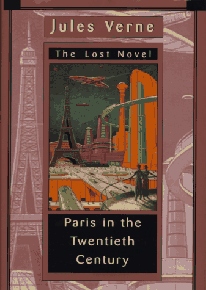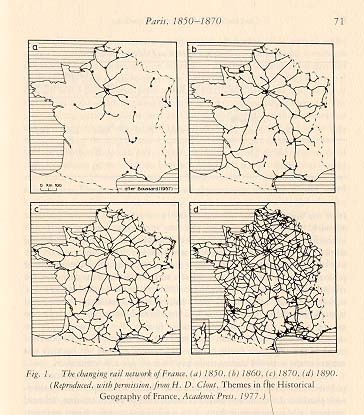Miriam R. Levin, “Bringing the Future to Earth in Paris, 1851 – 1914
A Vision of Progress
PART I SETTING THE SCENE
Jules Verne’s unpublished novel Paris in the Twentieth Century (1863) is the tale of an aspiring young poet adrift in a future metropolis monopolized by science and  technology. Pneumatically driven elevated trains, electrically lit streets, homes fitted with mechanical gadgets, libraries, research and educational institutions reflect and promote profitable investment in urban industrial progress. The city is run by an interlocking oligarchy of state administrators and capitalist bankers, who keep institutions on track by applying science and technology to urban development, record keeping, and accounting. A vast corporation called “ The Academic Credit Union ” oversees cultural innovation and its dissemination for instruction and amusement. At annual festivals held in its modern precincts on the Champ de Mars, the Union awards prizes to graduates for useful contributions to scientific and technical fields. A few are reserved for the arts — considered refreshing diversions for a hard-working population in thrall to industrial profit-making. In all, the future Paris is a drearily cheerful techno-system where “ construction and instruction are one and the same for businessmen, education being merely a somewhat less solid form of edification. ”
technology. Pneumatically driven elevated trains, electrically lit streets, homes fitted with mechanical gadgets, libraries, research and educational institutions reflect and promote profitable investment in urban industrial progress. The city is run by an interlocking oligarchy of state administrators and capitalist bankers, who keep institutions on track by applying science and technology to urban development, record keeping, and accounting. A vast corporation called “ The Academic Credit Union ” oversees cultural innovation and its dissemination for instruction and amusement. At annual festivals held in its modern precincts on the Champ de Mars, the Union awards prizes to graduates for useful contributions to scientific and technical fields. A few are reserved for the arts — considered refreshing diversions for a hard-working population in thrall to industrial profit-making. In all, the future Paris is a drearily cheerful techno-system where “ construction and instruction are one and the same for businessmen, education being merely a somewhat less solid form of edification. ”
Like all good writers of science fiction, this popular inventor of the genre signaled the salient features of his time. Writing in the midst of Napoleon III ’ s extensive rebuilding of Paris, Verne put his finger on two major developments in the city that continued to evolve under the early Third Republic: first, the assumption of a central role by elites in creating and administering new Paris-based institutions, organizations, and bureaucratic offices that structured modern industrial society; and, second, the commitment of these leaders to steering society along the path of progress via scientific and technological advances inaugurated in Paris. Especially important is the way they used a cluster of mutually reinforcing activities, in which these advances were embedded, to extend the geographic and imaginative reach of the new urban culture. For Verne’s elites, these projectscentered on infrastructure building, festivals, and scientific and technical education in the city. Similarly, the men of the Second Empire and Third Republic combined urban rebuilding (including the erection of laboratories and schools), universal expositions, and museums to restructure Parisians ’ reality. The appeal of these activities lay in their ability to simultaneously symbolize and materially advance an industrial capitalist system.
 This chapter examines the activities of three generations of men who inaugurated, developed, and extended this modern culture of change in Paris over the latter half of the nineteenth century and the first fourteen years of the twentieth. Readers are right to note that these generations span two regimes and two very different forms of government. There are
This chapter examines the activities of three generations of men who inaugurated, developed, and extended this modern culture of change in Paris over the latter half of the nineteenth century and the first fourteen years of the twentieth. Readers are right to note that these generations span two regimes and two very different forms of government. There are
good reasons, however, why the following pages consider them together.
Overlaps in agendas, means, and personnel argue for establishing the continuitiesmarking the advent of this culture in Paris — the city that Walter Benjamin baptized “ the capital of the nineteenth century. ” Looking at distinctive differences between the forms of government, the policies regarding the Catholic Church, and the objectives of elite groups help account for changes in the character of urban modernity in Paris in the late nineteenth and early twentieth centuries.
Paris-based elites wished to master the forces of industrialization by constructing a set of science- and technology-based institutions, values, organizations, and spaces. The urban environment of the nation’s capital became the site where economic uncertainties and social strife would give way to a future seemingly insured against such difficulties. In Paris a controlled sense of the present materialized in rational aesthetics of open vistas, logically proportioned buildings, green parks, and squares, while visible and hidden improvements to the city’s infrastructure orchestrated a host of new social and economic relationships. The plans city leaders devised for the universal expositions were designed to symbolize and inaugurate the creation of ideal industrial societies, and broaden the international cooperation thought necessary for their realization. Materially, the fairs’ construction and servicing offered government officials periodic spurs to continue developing Paris's infrastructure and its neighborhoods, as well as to stimulate its economy. While the fairs seem to have been focused on the future, they also fed the population’s growing awareness of the past as governments moved exhibit collections to existing museums and founded new museums in fair buildings, increasing the presence in Paris of these institutions housing the past. Additionally, under Napoleon III and especially under the republicans, museums, laboratories, schools, and the university extended their role as sites in the city for scientific and technological research and
education.